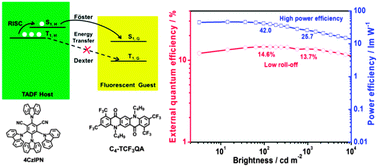Achieving high power efficiency and low roll-off OLEDs based on energy transfer from thermally activated delayed excitons to fluorescent dopants†
Abstract
Achieving high power efficiencies at high-brightness levels is still an important issue for organic light-emitting diodes (OLEDs) based on the thermally activated delayed fluorescence (TADF) mechanism. Herein, enhanced electroluminescence efficiencies were achieved in fluorescent OLEDs using a TADF molecule, (4s,6s)-2,4,5,6-tetra(9H-carbazol-9-yl)isophthalonitrile (4CzIPN), as a host and quinacridone derivatives (QA) as fluorescent dopants.


 Please wait while we load your content...
Please wait while we load your content...